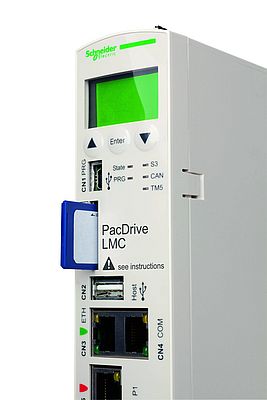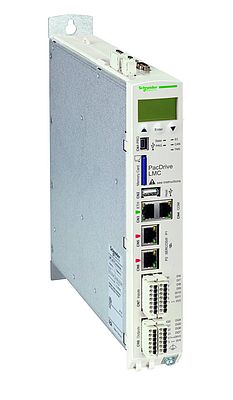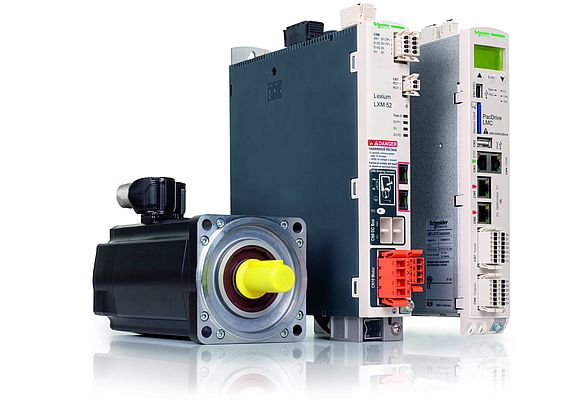Schneider Electric has enlarged its PacDrive 3 product line with the introduction of the new LMC 101/201 C controllers, which improve scalability in applications with eight and fewer synchronized servo axes. PacDrive now provides even more competitive advantages for a wide range of industrial machine applications.
The new LMC 101 C and LMC 201 C controllers supplement PacDrive 3's existing LMC 300 C, 400 C, and 600 C controllers. They refine controller performance scalability for applications requiring fewer than eight axes, and thus create a truly universal system for up to 99 synchronizable servo axes.
These new controllers are a key factor in Schneider Electric's strategy of developing previously untapped user potential for PacDrive. With the LMC 101 C and 201 C, Schneider Electric has optimized its product offering for traditional customers whose day-to-day operations use servo-based production and packaging machine with eight or more servo axes, as well as axes with robotic elements. These customers require fully integrated control systems that can handle both simple machines and high-performance systems, with full portability of machine programs and standardized, universally applicable SoMachine Motion tools. For simple machines, however, cost pressures are also driving the use of more economical control solutions without expensive functional overhead.
The LMC 101 C / 201C will also make PacDrive technology more attractive in completely new segments of the machine building sector, drawing users who have traditionally used PLC-based automation concepts. Such groups include manufacturers of textile machinery and wood, glass, or even ceramic processing equipment. Applications can also be found in a number of other industries, such as paper cutting machinery, machines for attaching carry-handles, placing package inserts in cartons, and so on. The range of such simpler applications is enormous. In the face of higher demands for productivity and flexibility in their machinery, machine builders from these industries are also increasingly utilizing servo technology.
Combination with stand-alone servo drives
The LMC 101 C/201C controllers now allow these users to use PacDrive controllers in their applications as well. These controllers are a particularly good match for the new Lexium LXM 52 series stand-alone servo drives. The LXM 52 has the same form factor as the LMC 101 C and 201 C, one that differs slightly from other PacDrive LMC products, but it still includes onboard features such as line filter and power supply to fulfill all the requirements for lean automation solutions and applications with fewer servo axes.
The LMC 101 C synchronizes up to four servo axes with a cycle time of 1 ms, while the LMC 201 C can synchronize up to eight. Just as with the more powerful models, both of these controllers can also synchronize up to 256 virtual axes. One new PacDrive feature is the use of Intel Atom processors in both of these controllers.
As with all PacDrive controllers, the LMC 101 C and 201 C also combine motion control and robotic control functionalities on a single control platform with a powerful PLC that can process 1000 bit PLC instructions in 5 µs. They can also program up to 4096 cam discs with a cam cycle time of 250 µs. Electronic cam discs can be switched during operation.
Sercos and CANopen on board
One strength of the LMC 101 C / 201 C is its wide range of communication with a 1 ms cycle time. The basis for communication is the rapid Sercos III system. Thanks to Sercos III's universal profile as an automation bus, Sercos communication can also extend beyond communication with drives to include I/O and safe communication.
In addition to the Sercos interface, each of the controllers also has one Ethernet and one CANopen interface on board. The principle of "one slot - one interface card" allows the system to be expanded with a Profinet, Ethernet/IP, or Profibus DP interface. In addition to the fieldbus interfaces, the controllers also offer a serial interface, an encoder input (for Sin/Cos or incremental encoders), and a USB interface.
The 12 digital inputs and eight digital outputs integrated into the front of the unit allow users of simple, cost-sensitive automation solutions to avoid the need for separate terminals integrated into the communication network with Sercos bus couplers. Four of the inputs are designed as fast counters or touch probe inputs. If additional digital inputs are required, they can also be created through integrated inputs in the new LXM 52 stand-alone servo drive. Of course external I/Os can also be added: The sercos III bus interface for the Schneider Electric universal TM5/TM7 I/O system let you create distributed I/O solutions for rapid communication in IP 20 and IP 67 as well.
Sophisticated plug-and-play
The new controllers use a dual-level concept for storing application data. The primary storage medium is a 512 KB SD card that functions as a boot drive and program memory. The SD card can be easily copied and, most importantly, transported. If a controller needs replacement, all the necessary data can be easily transferred to the new controller. External drives can be connected to the controller's USB interface for high data volumes requiring greater storage capacity.
To provide greater availability and usability, the LMC 101 C and 201 C also include all the functionalities that make PacDrive technology so attractive. As in larger models, these controllers can also automatically parameterize the servo solution components upon initial startup or after replacement of individual components, and, thanks to Sercos III, can now automatically assign bus addresses as well. The system automatically performs an update if it finds drive solution components with incorrect firmware versions.
Extensive diagnostic capabilities, traditionally one of the strengths of PacDrive technology, have also been fully implemented in LMC 101 C/201 C. An LED display on the front of the unit supplies information on operational status, and the similarly integrated four-line alphnumeric display shows the firmware version, IP address, and other basic information. In the event of a malfunction, the system displays a plaintext message on potential causes for a number of situations. The integrated message logger can also be read out. Three buttons below the display allow for intuitive navigation through the menus.
Foot in the door to the world of high-end technology
As cost differentials decrease, users may ask whether PLC-based control technology is still sufficient for motion control elements, or whether it might be better to use the more evolved logic motion control technology. Here, the answer is clear: the new LMC 101 C/201 C controllers offer users access to high-end technology that already anticipates future technical requirements.
These controllers incorporate the latest Ethernet-based communication based upon PacDrive 3, while simultaneously creating the opportunity to change over from hardwired safety designs to integrated concepts. The motion control synchronization quality and cycle times delivered by PacDrive are among the best on the market. Another trendsetting feature is the programming concept, which has been designed for modular machines and features a highly evolved, comprehensive inventory of library functions. All these features, and more, are essentially "Formula One technology for the family car." LMC x01 C controllers provide an incentive to many users who may have previously felt that PLC-based control designs enhanced with motion control functionalities would be sufficient for their machines.



















